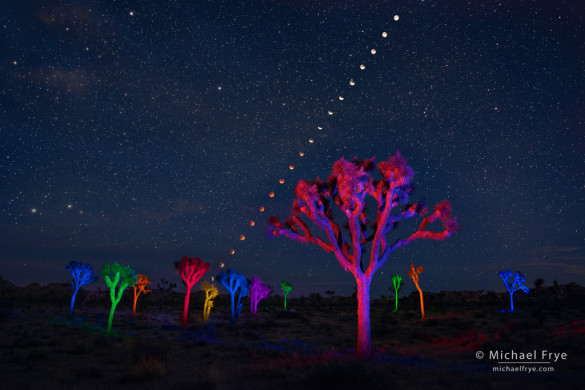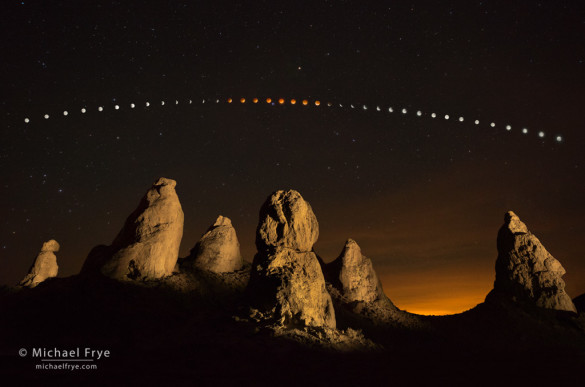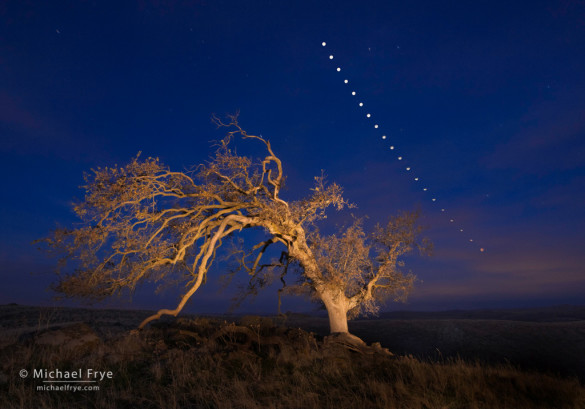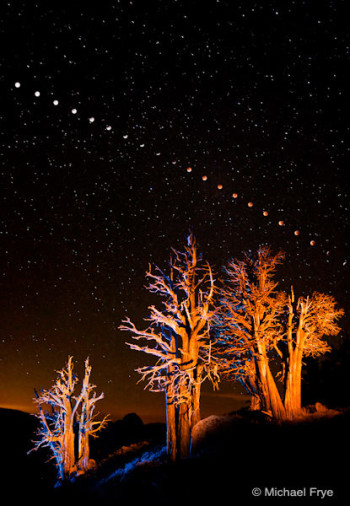by Michael Frye | Nov 17, 2015 | Night Photography

Lunar eclipse sequence with light-painted Joshua trees, September 27th, 2015, Joshua Tree NP, CA, USA
Here, finally, is my photograph of the lunar eclipse on September 27th. We went to Colorado right after this, and then to the eastern Sierra, and in the middle of all that I had to deal with a computer problem, so it’s taken me awhile to put together this sequence.
You might recall that I had planned to go to Death Valley or the Alabama Hills for the eclipse, but a stream of high clouds threatened to block the view, so at the last minute we decided to head further south, away from the clouds, to Joshua Tree National Park.
(more…)
by Michael Frye | Sep 22, 2015 | Night Photography, Photography Tips

Lunar eclipse sequence, April 14th and 15th, 2014, Trona Pinnacles, CA, USA
We’re going to get another chance to photograph a lunar eclipse this Sunday evening in North America and South America (or early Monday morning in Europe and Africa).
This eclipse also coincides with the moon’s perigee, meaning that the moon will be at its closest point to the earth during its orbit, and will look bigger than usual. The media is going to make a big deal about this “supermoon,” but the moon will only look seven percent larger than average, a difference that won’t be readily apparent to the naked eye, much less in photographs.
However, every total lunar eclipse is special – a spectacular event to view and photograph. And unlike the last one in April, this one will feature a long total eclipse phase.
(more…)
by Michael Frye | Mar 31, 2015 | Night Photography

Oak tree and lunar eclipse sequence, Mariposa County, Sierra foothills, December 2011
Another total lunar eclipse will be visible in western North America this Saturday morning, April 4th. This is the third lunar eclipse in a sequence of four: we had two last year, and there will be another one on September 27th this year. But after that you won’t be able to see another total lunar eclipse in North America until 2018.
This upcoming eclipse will be brief; the total eclipse will last only five minutes! But for photography that’s enough. Here in California the eclipse will be visible in the west-southwest, about 18 degrees above the horizon, just before dawn. Since the moon will be low in the sky, you might be able to photograph it next to an interesting foreground object. You can find more details about this eclipse here.
For precise guidance about the moon’s position in relation to the landscape, I recommend consulting PhotoPills or The Photographer’s Ephemeris. Here’s the timing for the eclipse:
(more…)
by Michael Frye | Oct 5, 2014 | Night Photography

Lunar Eclipse Sequence, 1:23 a.m. to 4:49 a.m., August 28, 2007, Yosemite National Park, California
Lunar eclipses are spectacular events to see and photograph. I’ve been lucky enough to capture several lunar eclipse sequences over the years, including this one from Yosemite in August 2007.
We’re all going to get another chance at photographing an eclipse soon: a total lunar eclipse will be visible throughout North America early Wednesday morning, October 8th.
In the western half of the U.S. the entire eclipse sequence will be visible, from full moon, to partial eclipse, to total eclipse, and back to full again. In California the moon will be high in the sky to the west-southwest at the beginning of the sequence, then sink near the horizon to the west by the end of the sequence. The moon’s path will actually be somewhat of similar to path in this photograph, except that the eclipse will be higher in the sky and a bit further to the right, and the angle of the moon’s path will be steeper.
On the east coast the moon will set when its fully eclipsed, so it won’t be visible as its coming out of the eclipse. But that means the moon will be near the horizon when its fully eclipsed, where you might be able to photograph it next to an interesting foreground object as the dawn lightens the sky. It should be just north of due west as it sets.
For precise guidance about the moon’s position in relation to the landscape, I recommend consulting PhotoPills or The Photographer’s Ephemeris. Here’s the timing for the eclipse:
(more…)
by Michael Frye | Apr 17, 2014 | Night Photography

Lunar eclipse sequence, April 14th and 15th, Trona Pinnacles, CA, USA
Monday night’s lunar eclipse didn’t seem to line up well with any of Yosemite’s features, so I started looking for other locations – preferably someplace with clear, dark skies, and an interesting foreground. Death Valley came to mind, but then I thought of the Trona Pinnacles, near Ridgecrest. I’d never been there, but it seemed like an appropriately “lunar” landscape – so much so that the pinnacles have frequently been used to represent alien landscapes in sci-fi movies, including Star Trek V and Planet of the Apes.
Claudia and I drove down there on Monday and arrived about an hour before sunset. And what a great spot! I wondered why it had taken me so long to visit this striking landscape. The pinnacles are actually ancient tufa towers, like those at Mono Lake, left high and dry by the evaporation and shrinking of Searles Lake.
(more…)












